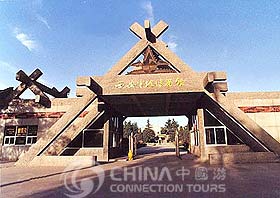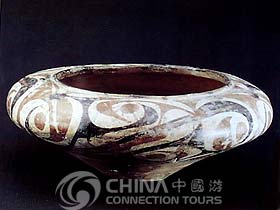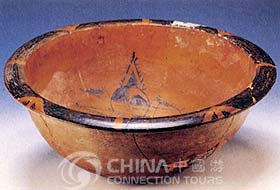
 The Banpo Museum is located some three miles to the east of Xi'an City in Shaanxi Province. It is near the bridge that crosses the river, long renowned as one of the famous eight rivers of Chang'an. The Museum was built in 1958 and is the first museum built for a 'mankind site,' a habitation site of early man. Its name comes from its location on the northern side of Banpo Village. In 1957, the Government of Xi'an built the museum basing on archeology and diggings, and the museum was officially open on the 1st day of April. In 1962, the State Department of the People's Republic of China announced that the Banpo Site a national major unit of cultural relic that should be protected. The Banpo Site was found in 1953, it covers almost 50,000 square meters presently, and through archeology, 10,000 square meters was dug, it was divided into several districts respectively for inhabitancy, ceramics and graves.
The Banpo Museum is located some three miles to the east of Xi'an City in Shaanxi Province. It is near the bridge that crosses the river, long renowned as one of the famous eight rivers of Chang'an. The Museum was built in 1958 and is the first museum built for a 'mankind site,' a habitation site of early man. Its name comes from its location on the northern side of Banpo Village. In 1957, the Government of Xi'an built the museum basing on archeology and diggings, and the museum was officially open on the 1st day of April. In 1962, the State Department of the People's Republic of China announced that the Banpo Site a national major unit of cultural relic that should be protected. The Banpo Site was found in 1953, it covers almost 50,000 square meters presently, and through archeology, 10,000 square meters was dug, it was divided into several districts respectively for inhabitancy, ceramics and graves.
The site marks a settlement that dates to the matrilineal clan commune period of the Neolithic period. The arrangement of the Neolithic village was quite organized. At the center of the settlement was a 160-square meter-large room that was surrounded by many smaller rooms. All of the doors of these faced the inside larger room, reflecting the clan spirit of a cohesive group. Around the village was a 300-meter long trench or ditch that was used to keep wild animals from attacking. To the east was a ceramic-making area and to the north was the cemetery district. Inside the town were some 46 houses. Some were square, some round, some half-submerged in the ground, some on the surface. These houses already used traditional Chinese wall-construction methods and can be called precursors of later Chinese architecture that used wood and earth.
 The display exhibition of the Banpo Museum covers almost 4500 square meters, divided into 3 parts, the display of the unearthed cultural relics, the hall of the site and the auxiliary display. The display of the unearthed cultural relics is composed of 2 exhibition rooms. They're the No.1 room and the No.2 room. In these two rooms, many things are exhibited. There're the Banpo Site and the manufacture implements. There are living appliances and artworks used by the primitive people. And the hall of the site was a part of the living district of the primitive people in Banpo. All these show the original appearance after being found. And it covers almost 3000 square meters, including the rooms where the former human beings lived, and the stoves, kilns and graves used and etc. used by them. There are the No.3 and the No.4 exhibition rooms in the auxiliary display, mainly holding some special exhibitions of ethnogeny, folklore, history of art and palaeoanthropology related to the prehistoric culture. The decorations on the great door of the style of the primordial villages, the stone carving of the bailing girl of Banpo standing in the fish pool, and the 4 powerfully meaningful Chinese characters "Banpo Ruins" written by Mr. Guo Moruo on the front of the gate, all give more sentiment to the cultural atmosphere of the Banpo Museum, and make people have a real feeling of returning to nature and history. And all these scenes always make many people on the scoop. In the recent years, the museum built the Banpo village of enatic tribes reflecting the conditions of the manufacture and life of the primitive society. It's the organic extension of the display of the Banpo Museum for reproducing solidly the society of the enatic tribes. It has moved the precious heritages from under the earth to on the earth according to the materials of archeological discoveries. The precondition of this is to protect the relics positively. The village enriches the connotation of the museum, carries forward the centuries-old Chinese cultural history, and gathers together the prehistoric art in the drainage of the Huanghe River, mores and rurality. And it's praised as "the first Chinese historical village" by visitors from China and foreign countries for exerting the predominance of the culture, integrating the scientific research, archeology, teaching, tourism and entertainment.
The display exhibition of the Banpo Museum covers almost 4500 square meters, divided into 3 parts, the display of the unearthed cultural relics, the hall of the site and the auxiliary display. The display of the unearthed cultural relics is composed of 2 exhibition rooms. They're the No.1 room and the No.2 room. In these two rooms, many things are exhibited. There're the Banpo Site and the manufacture implements. There are living appliances and artworks used by the primitive people. And the hall of the site was a part of the living district of the primitive people in Banpo. All these show the original appearance after being found. And it covers almost 3000 square meters, including the rooms where the former human beings lived, and the stoves, kilns and graves used and etc. used by them. There are the No.3 and the No.4 exhibition rooms in the auxiliary display, mainly holding some special exhibitions of ethnogeny, folklore, history of art and palaeoanthropology related to the prehistoric culture. The decorations on the great door of the style of the primordial villages, the stone carving of the bailing girl of Banpo standing in the fish pool, and the 4 powerfully meaningful Chinese characters "Banpo Ruins" written by Mr. Guo Moruo on the front of the gate, all give more sentiment to the cultural atmosphere of the Banpo Museum, and make people have a real feeling of returning to nature and history. And all these scenes always make many people on the scoop. In the recent years, the museum built the Banpo village of enatic tribes reflecting the conditions of the manufacture and life of the primitive society. It's the organic extension of the display of the Banpo Museum for reproducing solidly the society of the enatic tribes. It has moved the precious heritages from under the earth to on the earth according to the materials of archeological discoveries. The precondition of this is to protect the relics positively. The village enriches the connotation of the museum, carries forward the centuries-old Chinese cultural history, and gathers together the prehistoric art in the drainage of the Huanghe River, mores and rurality. And it's praised as "the first Chinese historical village" by visitors from China and foreign countries for exerting the predominance of the culture, integrating the scientific research, archeology, teaching, tourism and entertainment.
 In the northern part of the Banpo Village is the cemetery district where adults were buried. Some 174 graves have been discovered, lined up in regular order, but exhibiting different burial customs. Banpo people mostly died around the age of 30. On the eastern side of the town is the Public Kiln for firing pottery. Six kilns have been found to date. At the beginning, the pottery making was carried out in the open. By the time of Banpo, people had invented two main types of horizontal and upright kilns. Banpo ceramic production used both fine-grained clay and sandy coarse clay; the fine-grained was of three types depending on its use. Banpo people used realistic methods of painting to decorate their ceramics, with sketched designs to exhibit the characteristics of various animals.
In the northern part of the Banpo Village is the cemetery district where adults were buried. Some 174 graves have been discovered, lined up in regular order, but exhibiting different burial customs. Banpo people mostly died around the age of 30. On the eastern side of the town is the Public Kiln for firing pottery. Six kilns have been found to date. At the beginning, the pottery making was carried out in the open. By the time of Banpo, people had invented two main types of horizontal and upright kilns. Banpo ceramic production used both fine-grained clay and sandy coarse clay; the fine-grained was of three types depending on its use. Banpo people used realistic methods of painting to decorate their ceramics, with sketched designs to exhibit the characteristics of various animals.
Around twelve different kinds of markings or symbols have been found on pottery fragments or on vessels at the site. Together they comprise the main types of strokes used in Chinese characters, such as upright, cross-wise, hooked, and so on. Writing did not exist at the time, but these marks or symbols almost certainly contained their own meanings for people at the time. A number of daily articles are also exhibited in the museum, such as stone axes, finely made fishhooks, fishbone forks, sharp bone needles, and all kinds of ornamentation made of stone, bone, and ivory.

